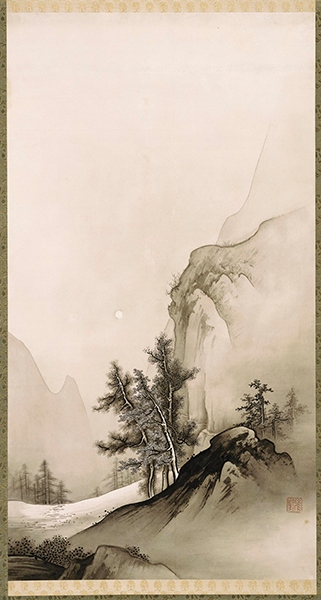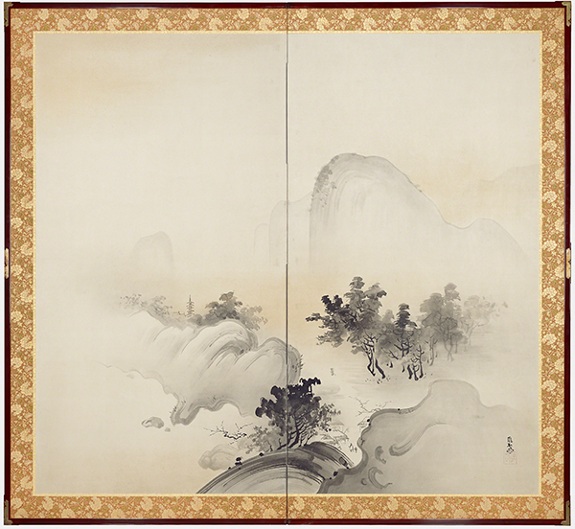Gem of the Month: Hashimoto Gahō
I have such an admiration for Japanese monochromatic painting that I decided to celebrate the firm establishment of autumn with one of my favorite nihon-ga artists, who was also featured for his wintery scenes last year. Hashimoto Gahō lived during a fermenting period in Japanese art history in which several of the tendencies of traditional Japanese painting emerged.
 |
| Hashimoto Gahō (1835–1908, Japan), Landscape with an Autumn Moon, 1880s–1890s. Hanging scroll, ink on paper, 34 ⅛" x 18 9/16" (86.7 x 47.2 cm). © 2021 Museum of Fine Arts, Boston. (MFAB-940) |
While his subjects and monochromatic approach are traditional to Japanese painting, Hashimoto adapted Western techniques for depicting form and depth with the use of chiaroscuro (the gradual nuances between light and dark). This was a particular skill that traditional artists had exploited to some extent in painting during the 1700s, but never with the dramatic three-dimensional effect of Hashimoto's works. Although he may never have seen the works, Hashimoto's landscapes are reminiscent of the American Hudson River School and Rocky Mountain painters who delighted in dramatic, mist-shrouded scenes.
During the Edo Period (1603–1867), isolationist rule limited outside influence, leading to a resurgence of historic styles, notably those of the Heian Period (794–1185). Increased trade with the West due to the Kyōhō Reforms of 1736 introduced Western art through imported books. Western art was accessible in large quantities for the first time in almost 250 years after the forced opening of Japanese ports in 1853, which had a major impact on Japanese art, particularly painting and printmaking. Artists had increased access to Western art during the Meiji "restoration" (1868–1912), including artists traveling to Europe.
Some Japanese artists of the late 1800s adapted Western styles, media, and subjects. For others, concepts such as perspective, chiaroscuro, and form reflected Western tendencies. The artists who embraced Western influence were referred to as yo-ga, "Western style painting." However, many Japanese artists maintained traditional Japanese art, a movement called nihon-ga, “Japanese style painting.” These artists adhered to traditional subject matter and techniques, including monochromatic ink painting.
Hashimoto is associated with the nihon-ga style. Born in Edo, Hashimoto was the son of Hashimoto Osakuni, a Kanō School-influenced artist and painter for Lord Matsudaira. Initially trained by his father, Hashimoto became the pupil of Kanō Shosen'in Tadanobu (1823–1880) when he was twelve. Kanō Hōgai (1828–1888), one of the pioneers of the nihon-ga style, was a fellow pupil and friend.
 |
| Hashimoto Gahō, Landscape, ca. 1903. One of a pair of two-fold screens, ink and gold leaf on paper mounted on wooden frame, 67 11/16" x 73 3/16" (172 x 186 cm). © 2021 Philadelphia Museum of Art. (PMA-8923) |
The individual elements of Hashimoto’s painting—the layering of elements to establish space; rich, detailed foreground to vague background forms; and energetic brushwork—are traditional. However, his use of chiaroscuro to establish distance between foreground, middle ground, and background is a real contrast to the traditional way Japanese artists indicated mist-shrouded distance. This example by Kanō Tanryu evinces the more traditional approach.
 |
| Kanō Tanryu (1727–1795, Japan), River Landscape. Ink and light color on paper, 50 ¾" x 11 ⅝" (129 x 29.5 cm). © 2021 Philadelphia Museum of Art. (PMA-8914) |
Correlations to Davis programs: Explorations in Art 2E Grade 1: 4.4; Explorations in Art 2E Grade 4: 4.4, 4.5; Explorations in Art 2E Grade 6: 2.2, 2.3; A Community Connection 2E: 4.5; A Personal Journey 2E: 5.4; A Global Pursuit 2E: 7.5; The Visual Experience 4E: 5.4; Discovering Art History 4E: 4.4


Comments